Home
Repair And Restoration
Coffee Liqueur In The Airbox
Shenanigans Date - 29 December 2020
By Ren Withnell
In the interest of not offending anyone, XXX = A generic type of person whom you find it humorous to believe they are stupid.
A XXX walks into a motor garage.
"Excuse me, yes, you, mechanic. My vehicle is running poorly. It starts poorly, won't accelerate like it used to and stutters on idle"
"Ah, hhmmm" the mechanic scratches while thinking "...yeah, poop in the carbs."
"Oh" exclaims the XXX "that's going to be difficult. Are you sure that will help?"
Bad-dum tishhh.
Anyhow, right, where was I. CBF125, that's right. Regular readers will know the long suffering CBF125 that has endured my cruelty for about 7 years now does like more than a soupscon of oil as a mixer with it's petrol while running. It's taste for 10w-40 is akin to that of an alcoholic and like an alcoholic I once knew while the liver is starting to suffer, outwardly everything is functioning as well as can be expected, save for the odd hiatus. Remarkable really, considering the abuse.
I got to thinking which usually for me is not a good thing. What could it be? Surely a mere 91,500 miles on an engine that only revs to 9,000 and spends most of it's time around 4 to 6 thousand can't be worn out? It's not so long back that I had a look inside and didn't really see much to worry about. What could cause it to burn oil?
Worn rings? Valve guides and/or seals? Head gasket? Think about the piston and combustion chamber, as this is the only place the oil can BURN. I emphasise burn because oil can also be lost due to excess heat causing the oil to vaporise, to "flash off". The engine did receive new valve stem seals and head gasket on the recent exploration and while I could have fitted them incorrectly or had an out of box failure, I shall ignore this for the time being.
While looking around I come across crankcase breathers. I know what they are and what they do. I am also reminded that a blocked breather increases the pressure in the crankcase and can cause excessive oil burning. I, well, I'm not at all convinced this is the problem but I might as well have a look see.
Removing the short pipe between the engine and the airbox is a simple affair. I look inside the pipe and save for a little, just a little splodge of that creamy white snotty emulsified oil the pipe is clear.

Engine to airbox, and simple to remove.
Where the pipe connects to the airbox there's a small drip of the coffee liqueur (I knew there was a a good reason to hate coffee). I poke a tiny screwdriver in there and more comes out. Hmmmm. I'll open the airbox, have a look see what is going on inside.
Honda made access to the air filter comparatively simple under the rider's seat, well done Honda. Of course below the air filter is not the empty chamber of the airbox but a metal gauze blocking passage. To get inside the airbox requires the removal of the top of the airbox. This requires removal of the tank. This requires removal of the side panels and fairing panels. Great, well done Honda.
The correct term for the breather *in this instance* is PCV, Positive Crankcase Ventilation. A breather vents to the open air which means the vapours that have flashed off from the engine oil and the blow-by from the piston rings is vented to the atmosphere.
This is considered bad form for the environment. As such Positive Crankcase Ventilation was created. The vapours are vented to the airbox and then drawn through the engine to be combusted. Some science happens and this process produces fumes marginally less damaging to the critters and animals.
The problem with PCV is the airbox, and thus the air filter, receive not only fresh(ish) air but also vapours of oil. To prevent the oil vapours reaching the usually paper type filter of modern vehicles and blocking them a baffle is put in the breather system. The idea is the oily part of the vapours has time to condense and drain back into the engine rather than clog the air filter.
Yeah, right. Ideally the baffle should be a complex array of passages, chambers and filters created by a genius engineering team with years of research and experience. The high quality aftermarket oil catch cans are an example of this. In reality on most vehicles you'll just have a tiny left-right-left passage and "it'll be reet enough".

The workings of a proper oil catch can.
The baffle on the CBF125 is in the bottom of the airbox. It is covered by a small piece of plastic - held on by 3 moulded blobs of plastic. This cover is obviously not meant to be removed, ever. But I can see the coffee liqueur oooozing out and around the baffle. It obviously needs to be cleaned and it's not a proper baffle and I'm curious and the bike has 91,500 miles and I don't care. I rip the piece of plastic off.
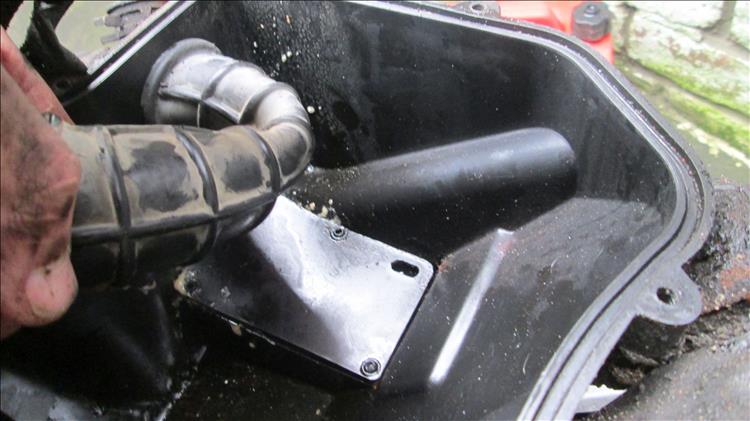
That cover is not meant to come off, but look at the emulsified oil.
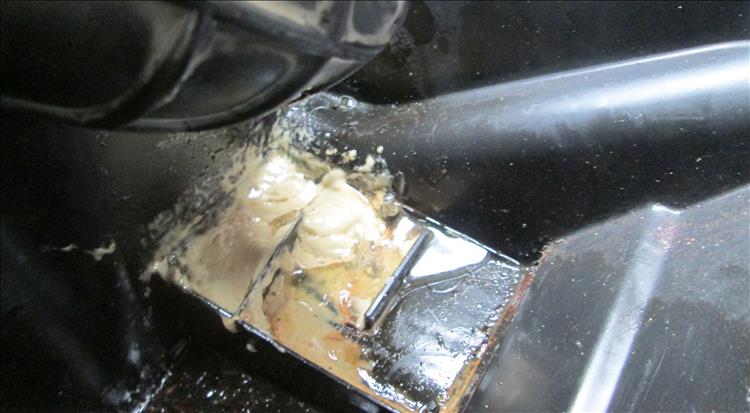
That doesn't suggest good clean breathing of the crankcase.
Looking at the contents within the baffle my first thought is to open a Barista Coffee Shop and sell this as a newfangled trendy coffee liqueur. I'm sure there's a bunch of hipsters that would pay £45 for a tiny sip of the latest trend, particularly if I tell them it was created from the bowels of a 1947 Wustlethorpe 450 Sidevalve. Instead I apply the overzealous use of a hosepipe and wash it all away. I'm not entirely sure if any of the water got into the engine though.
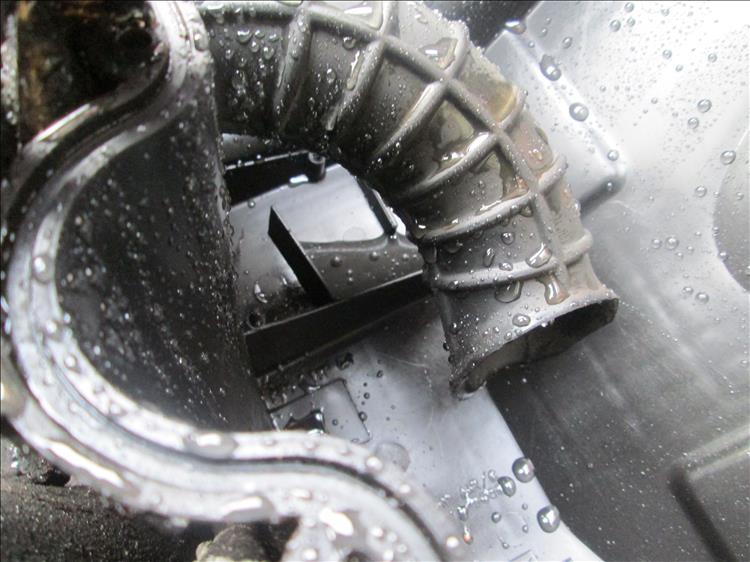
It's clean. The engine maybe hydrolocked but the baffle is clean.
Do I replace the plastic cover over the baffle section? Erm. No. It'll only fill up with snot again and anyhow I know my bike better than Honda does don't I...? Time will tell but I have safely stored the plastic cover between the gaps in the flags of the back yard, somewhere.
Has this fixed all my oil consumption woes? Is the crankcase now breathing freely? Can I expect to see another trouble free 91,500 miles? I don't know, it's not like I'm covering a lot of miles presently is it. I shall report back my findings but I don't expect them to be wondrously magnificent. Onwards and sideways, 2 steps forward and 3 steps back.
Add your own ridiculous mechanical shenanigans - click here.
Reader's Comments
Upt'North said :-
Call me a cynic Ed, CYNIC! Thanks for that.
I'm not that surprised there's, a bit of liqueur (I couldn't spell it either) in there after that mileage and cold weather usage. The emulsified oil is a cold weather problem in many engines, I had a OHV Ford where I had to remove the rocker cover a couple of times through the winter and you'd scoop handfuls of it out. It stank too.
It would seem your breather was clear young Ed, if so, I don't see you could have cured much. Have you thought about putting it into a catch bottle for a couple of weeks to see what it........catches?
I don't predict your poor bike will implode without the flap on, be fun though wouldn't it.
Thanks for keeping us entertained Ed and if you or anybody's passing the French Roast is in the pot.
Upt'North.
30/12/2020 14:42:39 UTC
Ren - The Ed¹ said :-
Oooooh French Roast. I'm on my way, I'll come on the 125 with a spare barrel of oil, just in case. Wait, hang on, we're not supposed to travel far. Gosh darn it! Will that French Roast be OK by post Upt'?
30/12/2020 15:39:10 UTC
nab301 said :-
Ren , is that baffle not connected to the outside world by the air filter housing drain pipe ? ( sealed with a removable cap and drained at regular intervals) Or is that pipe in a different part of the airbox?
Nigel
30/12/2020 15:53:17 UTC
Ren - The Ed¹ said :-
nab301 - on the CBF125 at least the baffle as you see it has the "incoming" vapours from the engine which then pass through the baffle then on into the airbox, and that is all. The airbox drain, picture below, is approximately 5 or 6 inches from the baffle and not at all connected. Never-the-less you are quite correct, this drain cap ought to be removed periodically to allow condensation and potentially emulsified oil (coffee liqueur) to drain. Something that is all to often overlooked by many riders, myself included.
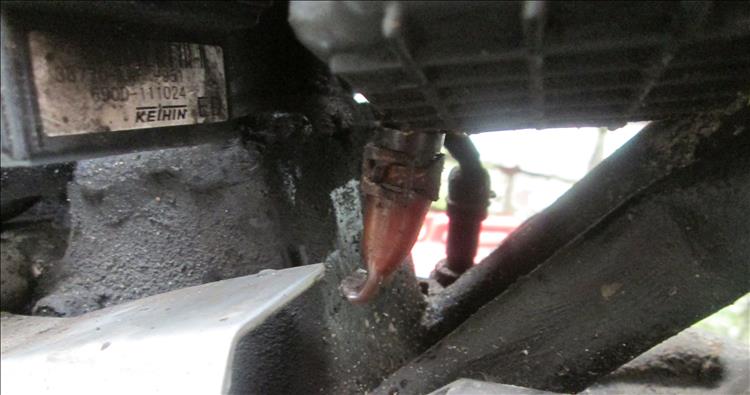 30/12/2020 16:41:48 UTC
30/12/2020 16:41:48 UTC
Ren - The Ed¹ said :-
This image is somewhat blurred but it shows how far the drain hole is from the baffle
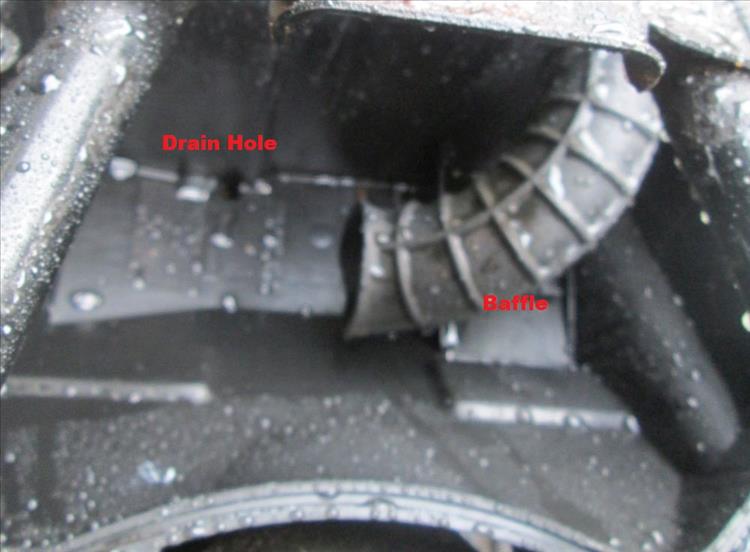 30/12/2020 16:45:09 UTC
30/12/2020 16:45:09 UTC
Upt'North said :-
Ed.....that little drain pipe thingymabob under the housing. Didn't they used to put slits in the end of them so there was no need to remove them. You'd just apply a little sideways pressure and the fluid would run out. I'm sure this is how they used to be finished as standard although yours looks like it's been dragged behind the bike around Manchester for a few hundred miles.
Jeff says he's going to try to cheer you up.......please don't be cheery......wouldn't be right.
Upt'North.
31/12/2020 11:24:49 UTC
Ian Soady said :-
The equivalent on my LR Discovery had little rubber valves that worked in the same way Mr North suggests.
31/12/2020 11:56:18 UTC
Ren - The Ed¹ said :-
I get what you mean, the drain is sealed until you simply squeeze it? But no, on this CBF125, the CB500X and all the other bikes I'm aware of there's this peculiar semi-transparent short orange pipe. I suppose the idea of it being transparent is you can quickly check to see if there's anything in there, but all the one's I've seen after a year or two of being ignored are opaque.
31/12/2020 15:30:06 UTC
Snod said :-
My CBX250RS has started to "lose" a lot of oil recently and I'm pretty sure it's because the seal around the clutch twisty-rod-thing has perished, after a ride the nipple on the end of the clutch cable is always dripping with oil. Maybe you have a failing seal somewhere like that? The seal around the output shaft would be a similar deal, not dripping when stood still because it's above the oil level but happily spraying it out when running along. Just a thought.
31/12/2020 16:55:18 UTC
Ren - The Ed¹ said :-
Much to my surprise there are no serious leaks on the 125 Snod. It did weep a little from the head gasket until that was recently replaced. There's oil around the output shaft but not engine oil and certainly not enough to explain the consumption. I've started using chainsaw chain oil as supplied by Mr Bogger for lubing the chain. I'm impressed so far and the consistency of the oil from the rear output sprocket is consistent with the chainsaw oil not engine oil.
That and it does smoke, particularly on start-up.
01/01/2021 11:00:06 UTC
said :-
13/01/2024 15:40:15 UTC
Name
Comment
Add a RELEVANT link (not required)
Upload an image (not required) -
Uploading...
Home
Repair And Restoration